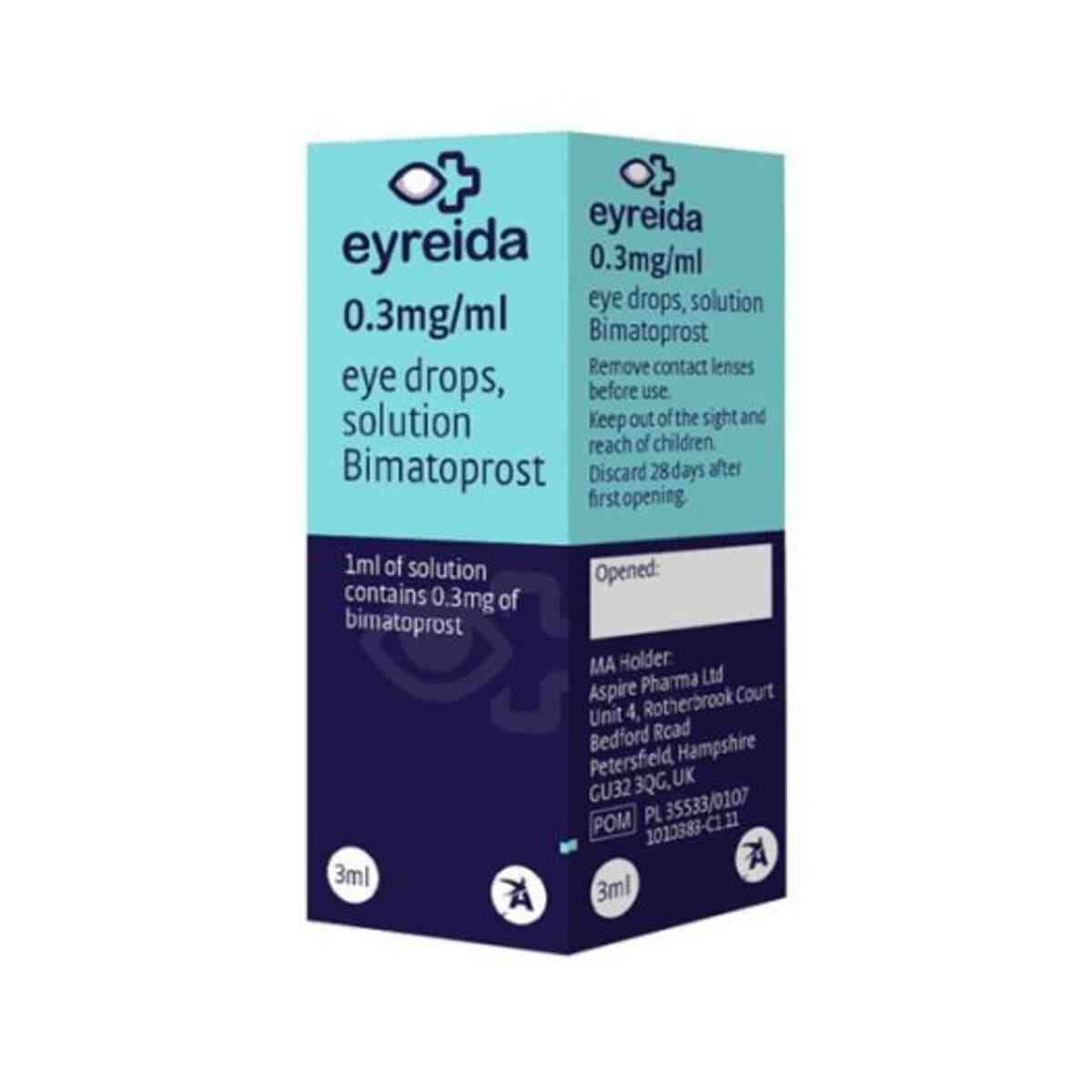Description
Eyreida Eye Drops, 3ml
Eyreida Eye Drops is an anti-glaucoma preparation. It belongs to a group of medicines called prostamides.
Eyreida is used to reduce high pressure in the eye in adults. This medicine may be used on its own or with other drops called beta-blockers which also reduce pressure.
The active substance is Bimatoprost ( bimatoprost eye drops )
Your eye contains a clear, watery liquid that feeds the inside of the eye. Liquid is constantly being drained out of the eye and new liquid is made to replace this. If the liquid cannot drain out quickly enough, the pressure inside the eye builds up. This medicine works by increasing the amount of liquid that is drained. This reduces the pressure inside the eye. If the high pressure is not reduced, it could lead to a disease called glaucoma and eventually damage your sight.
Eyreida eye drops solution is a sterile solution that does not contain a preservative.
What is Glaucoma?
Glaucoma is a common eye condition where the optic nerve, which connects the eye to the brain, becomes damaged.
It’s usually caused by fluid building up in the front part of the eye, which increases pressure inside the eye.
Glaucoma can lead to loss of vision if it’s not diagnosed and treated early.
It can affect people of all ages, but is most common in adults in their 70s and 80s.
Glaucoma does not usually cause any symptoms to begin with.
It tends to develop slowly over many years and affects the edges of your vision (peripheral vision) first.
For this reason, many people do not realise they have glaucoma, and it’s often only picked up during a routine eye test.
If you do notice any symptoms, they might include blurred vision, or seeing rainbow-coloured circles around bright lights.
Both eyes are usually affected, although it may be worse in 1 eye.
Very occasionally, glaucoma can develop suddenly and cause:
- intense eye pain
- nausea and vomiting
- a red eye
- a headache
- tenderness around the eyes
- seeing rings around lights
- blurred vision
Visit an opticians or a GP if you have any concerns about your vision.
If you have glaucoma, early diagnosis and treatment can help stop your vision getting worse.
Without treatment, glaucoma can eventually lead to blindness.
If you develop symptoms of glaucoma suddenly, go to your nearest eye casualty unit or A&E as soon as possible.
This is a medical emergency that may require immediate treatment.
There are several different types of glaucoma.
The most common is called primary open angle glaucoma. This tends to develop slowly over many years.
It’s caused by the drainage channels in the eye becoming gradually clogged over time.
Other types of glaucoma include:
- acute angle closure glaucoma – an uncommon type caused by the drainage in the eye becoming suddenly blocked, which can raise the pressure inside the eye very quickly
- secondary glaucoma – caused by an underlying eye condition, such as inflammation of the eye (uveitis)
- childhood glaucoma (congenital glaucoma) – a rare type that occurs in very young children, caused by an abnormality of the eye
Glaucoma can occur for a number of reasons.
Most cases are caused by a build-up of pressure in the eye when fluid is unable to drain properly.
This increase in pressure then damages the nerve that connects the eye to the brain (optic nerve).
It’s often unclear why this happens, although certain things can increase the risk, including:
- your age – glaucoma becomes more common as you get older
- your ethnicity – people of African, Caribbean or Asian origin are at a higher risk
- your family history – you’re more likely to develop glaucoma if you have a parent or sibling with the condition
- other medical conditions – such as short-sightedness, long-sightedness and diabetes
It’s not clear whether you can do anything to prevent glaucoma, but having regular eye tests should pick it up as early as possible.
The treatment recommended for you will depend on the type of glaucoma you have, but the options are:
- eyedrops – to reduce the pressure in your eyes
- laser treatment – to open up the blocked drainage tubes or reduce the production of fluid in your eyes
- surgery – to improve the drainage of fluid
You’ll also probably need regular appointments to monitor your condition and check the treatment is working.
Further Information on Glaucoma
Eyreida Eye Drops Reviews
After using Eyreida Eye Drops, it’s helpful to let others know about your experience. Reviews of an item help other users know that medicines received have helped the condition it is claimed for, how well the treatment worked or any issues to be aware of. We invite our users to leave a review of both their treatment and of the service provided. Click on the reviews tab to see if there has been feedback on this item.
Price of Eyreida Eye Drops in UK
Where to buy Eyreida Eye Drops
Eyreida Eye Drops is available to buy with a prescription at Dock Pharmacy Essex UK, UK Online Pharmacy.
Patient information leaflet
How To Use
Always use this medicine exactly as your doctor or pharmacist has told you. Check with your doctor or pharmacist if you are not sure.
The recommended dose is one drop in the evening, once daily in each eye that needs treatment. Eyreida should only be applied to the eye.
If you use Eyreida with another eye medicine, wait at least 5 minutes between using Eyreida and the other eye medicine. Use any eye ointment or eye gel last.
Do not use more than once a day as the effectiveness of treatment may be reduced.
Do not allow the tip of the multi-dose container to touch the eye or areas around the eye. It could cause injury to your eye. The eye drops solution may become contaminated with bacteria that can cause eye infections leading to serious damage of the eye, even loss of vision.
To avoid possible contamination of the multi-dose container, keep the tip of the multi-dose container away from contact with any surface.
Before instillation of the eye drops:
- Wash your hands before opening the bottle.
- Do not use this medicine if you notice that the tamper-proof seal on the bottle neck is broken before you first use it.
- At the first use, after cap removal, without positioning the eyedropper above the eye, slowly squeeze the bottle to deliver one drop in the air to get used to the pressure and time required to deliver one drop. In case of difficulties of delivering one drop at a time, this step might be repeated.
- Choose the position that you find most comfortable for the instillation of the drops (you can sit down, lie on your back, or stand in front of a mirror).
Instillation:
1. Hold the bottle directly below the cap and turn the cap to open the bottle. Do not touch anything with the tip of the bottle to avoid contamination of the solution.
2. Tilt your head backwards and hold the bottle above your eye.
3. Pull the lower eyelid down and look up. Squeeze the bottle gently in the middle and let a drop fall into your eye. Please note that there might be a few seconds delay between squeezing and the drop coming out. Do not squeeze too hard.
If you are not sure how to administer your medicine, ask your doctor or pharmacist.
4. Blink a few times so that the drop spreads over the eye.
5. Repeat the instructions 2. – 4. to deliver a drop into the other eye also, if your doctor has instructed you to do this. Sometimes only one eye needs to be treated and your doctor will advise if this applies to you and which eye needs treatment.
6. After use and prior to recapping, the bottle should be shaken once in a downwards direction, without touching the dropper tip, in order to remove any residual liquid on the tip. This is necessary in order to ensure delivery of subsequent drops.
7. After you have used all doses there will be some Eyreida left in the bottle. You should not be concerned since an extra amount of Eyreida has been added and you will get the full amount of Eyreida that your doctor has prescribed. Do not attempt to use the excess medicine remaining in the bottle after you have completed the course of treatment.
Do not use the eye drops for longer than 28 days after first opening the bottle.
Always use this medicine exactly as described in this leaflet or as your doctor or pharmacist has told you. Check with your doctor or pharmacist if you are not sure.
If you use more of this medicine than you should, it is unlikely to cause you any serious harm. Put your next dose in at the usual time. If you are worried, talk to your doctor or pharmacist.
If you forget to use this medicine, use a single drop as soon as you remember, and then go back to your regular routine. Do not take a double dose to make up for a forgotten dose.
Eyreida should be used every day to work properly. If you stop using Bimatoprost 0.3mg/ml eye drops solution the pressure inside your eye may go up, therefore talk to your doctor before stopping this treatment.
If you have any further questions on the use of this medicine, ask your doctor or pharmacist.
Delivery Options
Delivery options
All deliveries are subject to the availability of the product and product sale conditions been met.
Order & Collect
Free next-day collection from In-Store
UK Delivery
Standard Delivery within the UK £3.50 Delivery time 3-4 days
First Class Delivery within the UK £5.90 Delivery time 1-2 days
Priority Delivery within the UK £7.10. Next day delivery by 1pm. Order must be placed by 1pm. Priority delivery is only available Monday to Thursday.
Europe Delivery
Standard Delivery within EEC from £12.50 Delivery time up to 5 days depending on the local delivery service within your country.
Expedited Delivery within EEC £39.50 Delivery time 2 days. Delivery by DHL, UPS or TNT.
Rest of the World
Standard Delivery Rest of the World from £16.10 Delivery Time 10 – 15 Days
Expedited Delivery Rest of the World £55.09 Delivery 5 days. Delivery service by DHL, TNT or UPS
For more information see our Shipping Policy or view our Return policy.
Side Effects
Like all medicines, this medicine can cause side effects, although not everybody gets them.
If you get any side effects, talk to your doctor or pharmacist. This includes any possible side effects not listed in this leaflet.
Very common: may affect more than 1 in 10 people
- Slight redness of the eye
Common: may affect up to 1 in 10 people
- Small breaks in the surface of the eye, with or without inflammation
- Irritation of the eye
- Itchy eyes
- Eye pain
- Dry eyes
- A feeling that something is in your eye
- Longer eyelashes
- Darker skin colour around the eye
- Red eyelids
Uncommon: may affect up to 1 in 100 people
- Tired eyes
- Sensitivity to light
- Darker iris colour
- Itchy and swollen eyelids
- Tears
- Swelling of the see-through layer which covers the surface of the eye
- Blurred vision
- Headaches
- Hair growth around the eye
Not known: frequency cannot be estimated from the available data
- Asthma
- Worsening of asthma
- Worsening of the lung disease called chronic obstructive pulmonary disease (COPD)
- Shortness of breath
- Symptoms of allergic reaction (swelling, redness of the eye and rash of the skin)
- Ocular discomfort
- Skin discoloration (periocular)
In addition to the side effects for Eyreida, the following side effects have been seen with the preserved multi-dose formulation of Bimatoprost 0.3 mg/ml and may occur in patients taking Eyreida:
- Dizziness
- Burning sensation in the eye
- An allergic reaction in the eye
- Inflamed eyelids
- Difficulty in seeing clearly
- Sticky eyes
- Worsening vision
- Darker eyelashes
- Retinal bleeding
- Inflammation within the eye
- Cystoid macular oedema (swelling of the retina within the eye leading to worsening vision)
- Iris inflammation
- Eyelid twitching
- Eyelid shrinking, moving away from surface of the eye
- Eyes appear sunken
- Increased blood pressure
- Nausea
- Skin redness around the eye
- Weakness
- An increase in blood-test results that show how your liver is working
In very rare cases, some patients with severe damage to the clear layer at the front of the eye (the cornea) have developed cloudy patches on the cornea due to calcium build-up during treatment.
If you get any side effects, talk to your doctor, pharmacist or nurse. This includes any possible side effects not listed in this leaflet. You can also report side effects directly via the Yellow Card Scheme (website: www.mhra.gov.uk/yellowcard). By reporting side effects you can help provide more information on the safety of this medicine.
 +44 (0) 1375 846 316
+44 (0) 1375 846 316


